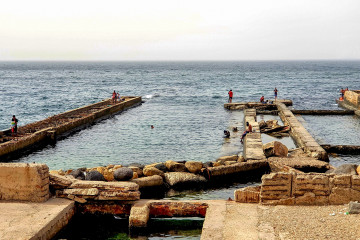

By and large, the international community has focused on the political troubles bedevilling Libya in the decade since rebels killed Muammar Gaddafi and dismantled his regime. In the intervening years, a constellation of regional powers has invested in rival Libyan governments and warlords, competing to determine the North African country’s fate. However, environmental issues with their own major implications for Libya’s future have all but escaped notice. Libyans, though, know the paradoxical challenges of flooding and water scarcity all too well.
The World Resources Institute, an environmental organisation, put Libya sixth in the world on its 2019 “National Water Stress Rankings” list. The United Nations Children’s Emergency Fund, better known as “UNICEF,” warned earlier this year that four million Libyans among a population estimated at almost seven million could “face imminent water problems,” a potential “humanitarian disaster,” if Libyan authorities failed to maintain desalination plants and repair wells.
The concurrent problem of floods has already had deadly consequences for Libyans. As far back as 2013, storms contributed to floods that swamped the Libyan capital of Tripoli. Three years ago, another storm caused flooding that forced the closure of the international airport in Benghazi, Libya’s second-biggest city. Just a year later, flash floods killed four and displaced 4,250 Libyans from the southwestern city of Ghat. Thousands of more displacements came last November after a downpour and consequent flooding in Bayda, in the northeast of Libya.
While foreign news agencies have documented the humanitarian crises sparked by flooding and water scarcity in Libya, headlines about the North African country’s political developments often overwhelm all other coverage. Plenty of outlets reported on the Libyan Political Dialogue Forum, convened this February to choose a new provisional government for the North African country. Libya’s environmental issues, by contrast, have only gotten an article here or there.
In at least one case, the possibility of an environmental disaster in Libya has received scant attention even when it intersects with the country’s political turmoil.
UNICEF’s 2021 advisory on water scarcity included a note about “repeated attacks on” the Great Manmade River, a series of pipelines constructed under Gaddafi’s reign that carry water to much of Libya’s population. Despite warnings since 2011 of the catastrophe that would result if this irreplaceable piece of infrastructure became a military target, few in the international community seem to be listening.
UNICEF warned earlier this year that four million Libyans among a population estimated at almost seven million could 'face imminent water problems,' a potential 'humanitarian disaster,' if Libyan authorities failed to maintain desalination plants and repair wells
Some sources describe the Great Manmade River as “the world’s largest irrigation project,” and Gaddafi himself called it “the eighth wonder of the world.” It moved 2.5 million cubic metres of water a day in 2017, comprising 70 percent of the freshwater used in Libya.
Benghazi, Tripoli, and other cities rely on the intricate water supply network, which became a major prize and suffered serious neglect during the decade-long civil war that followed Gaddafi’s death.
In a June research paper for the Arab Reform Initiative, the Libyan analyst Malak Altaeb urged Libya to decrease its consumption of water, expand the use of desalination plants, “develop water policies that are participatory and allow for management at the local level.” Altaeb argued that these measures could reduce dependence on the Great Manmade River and mitigate water scarcity in Libya, a crucial step if the country seeks to avoid an environmental disaster.
In addition to revamping Libya’s domestic policies, Libyan authorities will likely need support from the international community to confront the parallel challenges of flooding and water scarcity.
Officials in Tripoli had to dedicate 10 million Libyan dinars, equivalent to over $2 million, to rebuilding Bayda last year – a significant sum in a country that has watched its revenue from the petroleum industry plummet after years of political violence. Fixing damaged desalination plants and constructing new ones will likely prove expensive as well, requiring foreign funds.
Some aid agencies are moving in this direction. In 2019, the UN Development Programme provided $3.2 million to help Libyan authorities distribute humanitarian aid to flood-stricken areas. That same year, the US Agency for International Development, often shortened to “USAID,” sent Libya $31.3 to meet “humanitarian needs” that included “water, sanitation, and hygiene.” Following the Bayda floods, the European Union also lent assistance to Libya.
As promising as these initiatives seem, UNICEF’s recent warning about water scarcity indicates that the UN, USAID, and the European Union will have to do more if they intend to address this environmental issue in the long term. Bracing Libya for coming floods will likewise demand continuous foreign aid for the North African country to offer swift help to its population.
Last year, Libya’s ever-growing cast of domestic and foreign stakeholders came together to reach a landmark ceasefire between the nation’s military factions, diminishing the likelihood of attacks on the Great Manmade River, desalination plants, and other infrastructure.
Navigating the aftermath of floods has also become easier as the conflict dissipates. In a similar fashion, any effort to find a long-term solution to Libya’s environmental issues, foremost among them flooding and water scarcity, will need the buy-in of Libyan kingmakers and regional powers.
Austin Bodetti is a writer specialising in the Arab world. His work has appeared in The Daily Beast, USA Today, Vox, and Wired. Any opinion or analysis expressed in his work is by him alone and is not associated with any other entity with the exception of appropriate source attribution.






